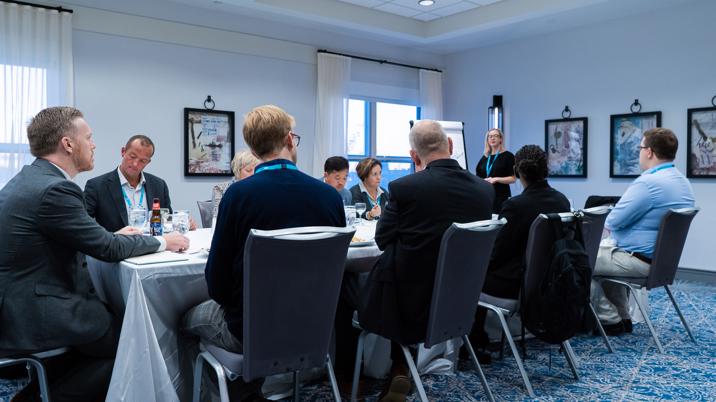
B2B publishers looking for new revenue streams are exploring ways to package content and data in a digital form for large organisations to provide to their staff. The likes of WGSN and HSJ Intelligence pioneered the development of premium data and intelligence products.
When HSJ was sold to Wilmington for £19m a couple of years ago, much of the value was in the intelligence product, not the venerable Health Services Journal itself. With HSJi achieving revenues of £3m, built from nothing in just three years, intelligence products seemed the new holy grail for media owners.
But many publishers have found it harder than they expected to develop a premium digital data product that they can sell to enterprises for in excess of £10k annually. The twin challenges are offering a compelling business case to the corporate buyer and creating a highly usable tool that their staff actually want to use to solve business problems.
The solution to both these problems is taking a highly disciplined approach to research and product development. In this article, I draw on my own experience and that of publishing leaders I have interviewed to map out the steps you need to take:
Ease of use and convenient access to key data is as valuable as having comprehensive data in the first place.
1. Do your research
• Understanding buyers: Enterprise buyers are focused on the business case for any new product. As with any high ticket B2B purchase, whether private or public sector, there are usually several people involved in the decision. So, your first step is to map out who is involved in a purchase decision and make sure you speak to people representing all the different job roles, which could include technical, sales or financial heads.
If you can talk to people face to face or over the phone, you can gain a better understanding of their business challenges, and the information and insight that their staff need to have to do their jobs better. This is an iterative process: as you start interviewing, you might uncover new business concerns and information needs.
You can also explore competitive information sources with your interviewees and get a first estimate of the scale of the value that your new product could deliver. This could be by making it easier to find prospects and close new deals, or by improving processes within the organisation, or even enhancing staff retention.
Independent B2B media business Chemical Watch embarked on an 18 month customer research programme among their existing subscribers. They appointed a dedicated chief customer officer to run the programme. As a result of their research, they reinvented their suite of subscription products into a single membership package with options for extensive personalisation. They also set up a customer council which is still being consulted regularly.
• Understanding users: Even if the enterprise buyer can see the business case and subscribes to your new product, it won’t be renewed if individual staff users can’t see the benefit to them. So, you also need to talk to users and really understand their own work challenges and information needs. Ensure that your research programme covers a wide range of users from different disciplines and levels of seniority.
Talk to them one to one and explore their main pain points and the information sources they use at the moment. If you can, get a sense of where and when during their working week they might want to consult an intelligence product, how they might want to output the information, and who they would share it with. These are important features in your product – ease of use and convenient access to key data is as valuable as having comprehensive data in the first place.
Use your insights from this stage to create a set of personas to describe the different segments of your user base and begin to map out how they might use your product in distinctive ways.
• Mapping the market size: Consider the ideal size of enterprise buyer – will you have the resources to market to SMEs, or are you focusing more on the bigger organisations with more at stake? How many prospective buyers exist in your target regions and how many users might there be in each organisation? This starts to give you an idea of the scale of the opportunity. Remember, it might take you several years to accumulate even 25-30% of the market, so you need to be confident that there is sufficient potential out there to justify your product development spend. English language B2B intelligence services can find a large market internationally, so overseas markets could provide additional scale.
• Competitor reviews: Your user and buyer interviews may have uncovered some unexpected competitors. It pays to keep an open mind, and explore what they do well and where there are gaps. Maybe your product will better meet the needs of one particular segment of employees within your target enterprise customers, so you would do well to focus your content on their needs. Map your competitors’ strong points in terms of content and functionality, and look for your own unique strengths.
• Content & data audit: Properly assess your in-house content and data, and the capabilities of your team to generate new types of content and data. Archive content can be a goldmine if well tagged and easy to search. Simple news articles can generate trend data and insights in the hands of smart analysts and experienced editors. What do you have that is unique, and valuable to your target customer?
Remember that business users are people – they like visually attractive and intuitive interfaces.
2. Design your product
• Develop personas: We touched on personas in the research phase, to help you segment both the purchasers and ultimate users of your new intelligence product. Now is the time to dig a little deeper, and build a more detailed profile of each, based on their work challenges, information needs and preferred approach to accessing and using data and content. This may involve going back for a second round of interviews, to get more insight on what they are looking for.
• Create a list of unique features: Refer back to your competitor research, your user and buyer interviews and your knowledge of your own content and data resources. Map out the key databases, archives, resources and forecasts that you could provide to users in a handy format. Consider how they might want to search, manipulate, compare, export and share with their colleagues. Build a list of the key features of your product.
• Review against personas and create use cases: For each persona, imagine how they might actually use your product in a work situation. Is there the right information? Is it easy to locate and analyse? What will they do with the information? How will they act on it? Remember that business users are people – they like visually attractive and intuitive interfaces.
• Work out the buyer business case: What is the business benefit to the buyer of their staff having access to this information? How will they measure it? What analytics can you build into the product that allow the buyer to discover which staff are using it and what information they are accessing. Think through how you might run the first renewal meeting and what information you would want to have available to prove ROI to the customer.
• Prepare content & data: After auditing your content and data, think through what you would need to do to prepare the data for a new product. What does this mean in terms of extra skills and resource, design and technical support? How long might this process take?
• Build your own business case: How long do you think it would take to convince customers to buy? What resources would you need to apply? What about your pricing structure? How much would it cost to build the product from a technical viewpoint, and to amass the content and data to populate it? What resources would you need to test the product, and maybe set up a panel of friendly customers to feedback on how well it meets their needs?
Consider what level of investment you are willing to make, and when you want to see a payback. Remember that digital intelligence products will need ongoing technical innovation and support, and the content and data will have to be refreshed and updated continually. Customers and end users will need training and support to learn how to get the best value from the product.
Digital intelligence products will need ongoing technical innovation and support.
3. Build your product
• Hire your dev team (in-house or agency): Only the very largest media organisations are likely to have the scale and skills to develop digital products in-house. Most will need to find a tech partner. This is a significant procurement process – so take your time to meet with agencies, understand their track record and capability, and explore how they will work with your team over a matter of years.
• Recruit a user group: Enlist some friendly prospective customers to provide regular feedback as you develop your product, and a good group of end users as well, to keep your ideas grounded in the reality of the workplace.
• Create and test an MVP: Keep your product simple to start with – the tech world’s concept of ‘minimum viable product’ is a good principle to adopt. Building anything new always takes far longer than anticipated, so keep your ambitions (and those of your Board) modest at first.
• Refine and improve with feedback from buyers and users: This is an iterative game. In line with the principles of agile development, start with something simple, then share it with your buyers and users, and keep making incremental changes without breaking the tech. This can be a cultural leap for those with a print publishing background who were accustomed to keeping the product under wraps for months and then launching a final product to advertisers and newsstand with a big fanfare. Getting this type of product right means thinking of your launch customers and user group as partners. You are evolving a product that will do a unique job for them, in the way they want it to.
To develop new, innovative, high value intelligence products, continual, thorough user research is absolutely essential to success. It might seem a laborious process when your editorial and marketing team are practically fizzing with their own creative ideas but involving your users as true partners from the beginning will result in a much better product that delivers value to the enterprise who foots the bill. And, in time, a high renewal rate to the media business who developed it.
Building anything new always takes far longer than anticipated.
This article was first published in InPublishing magazine. If you would like to be added to the free mailing list, please register here.










